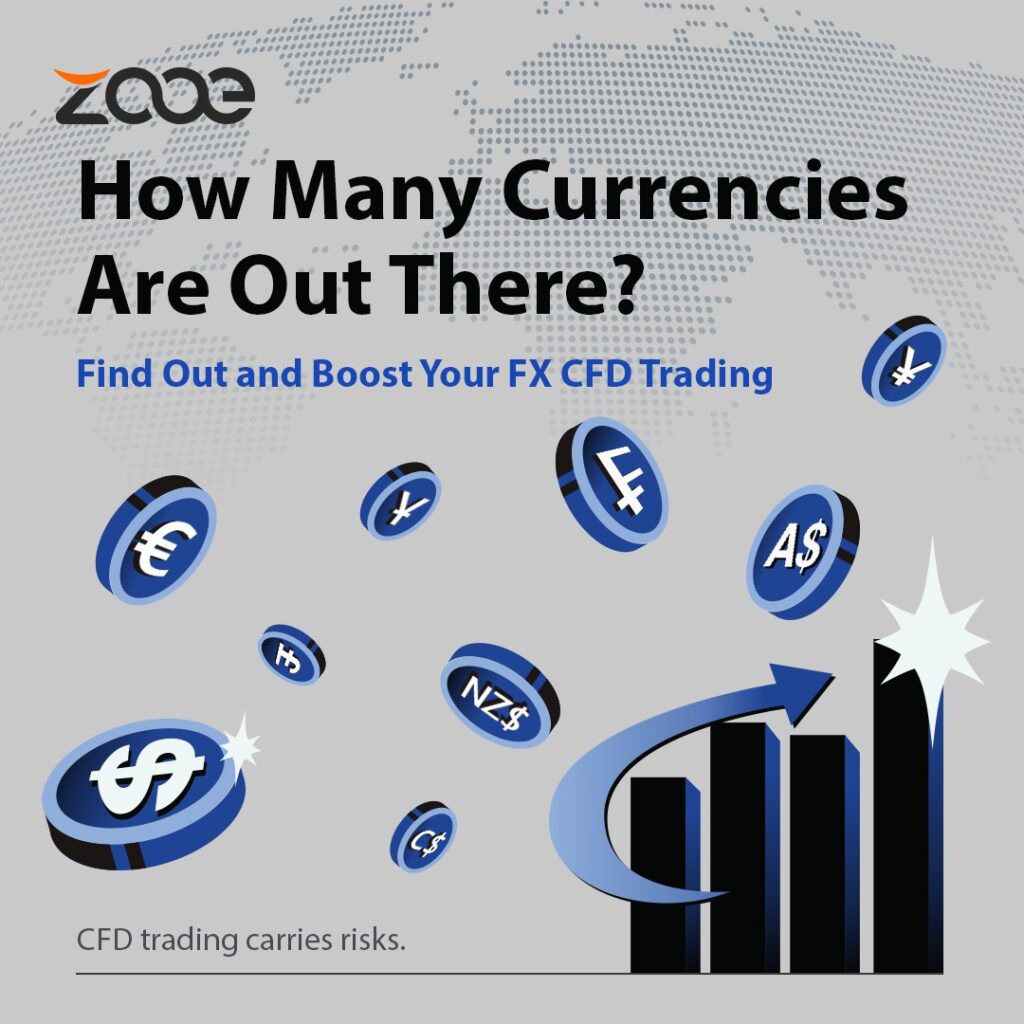Explore the World’s Key Currencies and Enhance Your FX Trading Strategy with Zooe

As of June 2024, there are 180 recognized currencies in circulation worldwide, according to the International Organization for Standardization (ISO 4217). Currencies are fundamental to the global economy, serving as mediums of exchange, stores of value, and units of account. They facilitate trade, support economic policy, and maintain financial stability.
The Importance of Currencies
Currencies are essential for enabling international trade and investment. They provide a standardized value that allows countries to engage in economic transactions. A strong currency reflects a robust economy, while a weak currency can indicate economic challenges. Understanding key global currencies is vital for traders and investors.
Key Global Currencies
USD – United States Dollar ($)
- Common Nickname: Greenback
- Nickname Origin: The term “Greenback” originates from the green color of the dollar bills.
- Importance: The USD is the world’s primary reserve currency, widely used in international transactions and held by central banks globally. It serves as the benchmark for many commodities and financial markets.
EUR – Euro (€)
- Common Nickname: Fiber
- Nickname Origin: The nickname “Fiber” is believed to come from the telecommunications term “fiber optics,” symbolizing the Eurozone’s advanced economic integration and modern infrastructure.
- Importance: The Euro is the official currency of the Eurozone, used by 19 of the 27 European Union member states. It is the second most traded currency globally and a significant reserve currency.
GBP – British Pound (£)
- Common Nickname: Sterling
- Nickname Origin: “Sterling” refers to the quality of silver used in British coinage, representing reliability and strength.
- Importance: The British Pound is one of the oldest currencies still in use and a major reserve currency. It plays a significant role in the global financial markets, particularly in foreign exchange trading.
AUD – Australian Dollar (A$)
- Common Nickname: Aussie
- Nickname Origin: “Aussie” is a colloquial term for Australian, reflecting the currency’s origin.
- Importance: The AUD is known for its commodity-linked valuation and is heavily traded in the forex market. It reflects the economic health of Australia and its trading partners, particularly in the Asia-Pacific region.
CAD – Canadian Dollar (C$)
- Common Nickname: Loonie
- Nickname Origin: The term “Loonie” comes from the image of the loon bird on the one-dollar Canadian coin.
- Importance: The CAD is closely tied to the value of crude oil, as Canada is a major oil exporter. It is one of the most traded currencies globally and reflects the economic conditions of Canada.
JPY – Japanese Yen (JP¥)
- Common Nickname: Yen
- Nickname Origin: Simply derived from its official name, “Yen,” reflecting Japan’s national currency.
- Importance: The JPY is a major global reserve currency and is often used as a funding currency in carry trades due to Japan’s low-interest rates. It reflects the economic strength of Japan, one of the world’s largest economies.
CHF – Swiss Franc (CHF)
- Common Nickname: Swissie
- Nickname Origin: “Swissie” is a diminutive term reflecting Switzerland’s national currency.
- Importance: The CHF is known for its stability and is often considered a safe-haven currency. Switzerland’s strong economy and political neutrality make the CHF a preferred currency during times of economic uncertainty.
NZD – New Zealand Dollar (NZ$)
- Common Nickname: Kiwi
- Nickname Origin: “Kiwi” is a colloquial term for New Zealand, derived from the national bird of New Zealand.
- Importance: The NZD is heavily influenced by the country’s agricultural exports and economic relations with trading partners in the Asia-Pacific region. It is a popular currency in the forex market due to its relatively high interest rates.
CNY/CNH – Chinese Yuan (CN¥)
- Common Nickname: Renminbi or RMB
- Nickname Origin: “Renminbi” means “people’s currency” in Chinese.
- Importance: The CNY (onshore) and CNH (offshore) are crucial for global trade, reflecting China’s significant role in the global economy. The Renminbi is increasingly used in international transactions and is part of the IMF’s Special Drawing Rights (SDR) basket.
- CNY (Onshore Yuan): This is the official currency used within mainland China and is subject to the monetary policies and regulations of the People’s Bank of China (PBOC).
- CNH (Offshore Yuan): This version of the Yuan is used outside of mainland China, particularly in Hong Kong. The CNH is subject to less regulatory control and can be influenced by international market forces.
Zooe’s Forex Trading Advantages
At Zooe, we provide our traders with unparalleled access to the forex market, offering advanced trading tools and comprehensive support. Here are some key advantages of trading forex with Zooe:
- Wide Range of Currency Pairs: Trade popular currency pairs with competitive spreads.
- Advanced Trading Platform: Our platform is designed for both novice and experienced traders, featuring real-time market data, advanced charting tools, and user-friendly trading interfaces.
- 24/5 Client Support: We offer round-the-clock multilingual support to assist you with any trading inquiries.
- Educational Resources: Access a wealth of educational materials, including tutorials and market analysis, to enhance your trading knowledge.
- Robust Security Measures: Your funds’ safety is our top priority. We adhere to strict regulatory standards and implement advanced security protocols to protect your investments.
Risk Disclaimer
Trading forex involves significant risk and can result in the loss of your invested capital. These products may not be suitable for all investors, so please ensure you fully understand the risks and seek independent advice if necessary. Ensure you only trade with money you can afford to lose.





